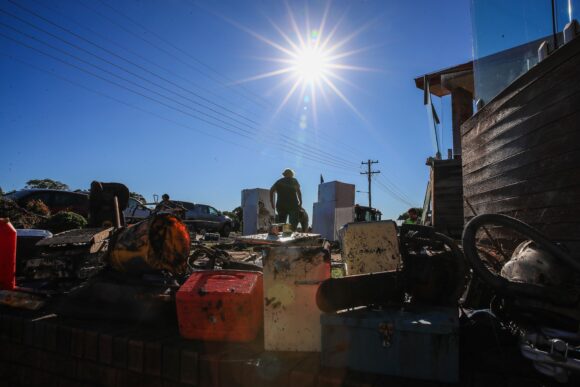Australia has drafted in emergency service teams from across the nation to help with clean-up operations after devastating floods in the eastern state of New South Wales.
Almost 200 additional personnel will take up specialist roles including water rescue, and storm and flood damage assessment, the NSW State Emergency Service said Sunday. About 32,000 residents are still isolated by floodwaters that are only slowly starting to abate.
The interstate personnel will also help the NSW SES review the damage to an estimated 10,000 properties.
“So far 480 damage assessments have been carried out, with building inundation seen in many locations, and many have sustained significant damage and are unhabitable,” said NSW SES Acting Assistant Commissioner Allison Flaxman. “We welcome the additional resources.”
Torrential rains last week in the region about 300 kilometers (186 miles) north of Sydney sparked widespread flooding that killed five people and swept away livestock, cut off towns and destroyed homes. NSW SES used drones to dispense essential medicine to communities that were isolated.
The Bureau of Meteorology said that while the rains have eased, weather conditions in coming days will be challenging, with high winds expected in the flood-ravaged areas as well as large ocean swells.
“What this means is we could be seeing some local inundation around the high tide for those really low-lying coastal areas to the middle part of the week,” said Gabrielle Woodhouse, a senior meteorologist at BOM.
Six emergency warnings remain in place for northern NSW, with residents urged not to enter floodwaters. Emergency services personnel have conducted 16 rescues in the past 24 hours, according to the SES.
Prime Minister Anthony Albanese is expected to visit the town of Taree, one of the hardest-hit communities, in coming days. He was unable to do so late last week as the area remained cut off by floodwaters.
Insurance Council of Australia Chief Executive Officer Andrew Hall told Australian Broadcasting Corp. that flood events were impacting the same communities time and again due to a lack of investment in making homes more resilient.
He said building up flood defenses is one of Australia’s “biggest challenges” due to climate uncertainty and a rising rate of underinsurance in cash-strapped households.
“We’ve got to break that cycle,” Hall said. “We have to be having these conversations in the dry times as well as the wet times.”
Top photograph: Debris are seen outside a flood-damaged house in Taree on May 24, 2025. Photo credit: Roni Bintang/Getty Images
Related:
Copyright 2025 Bloomberg.
Topics
Flood
Australia
Interested in Flood?
Get automatic alerts for this topic.
